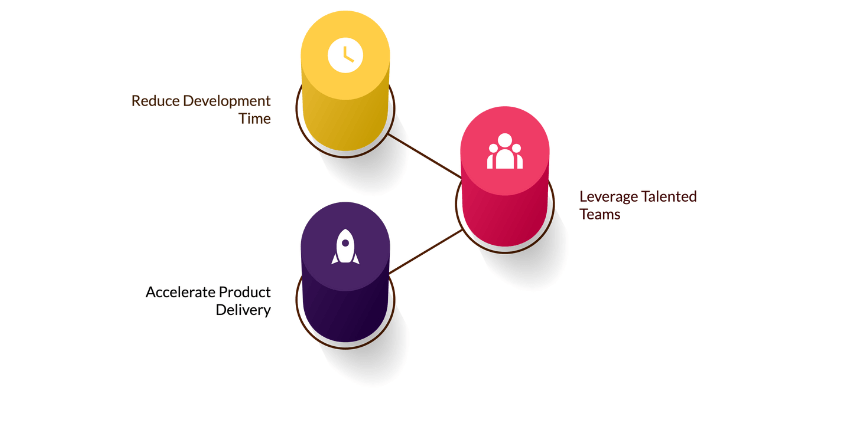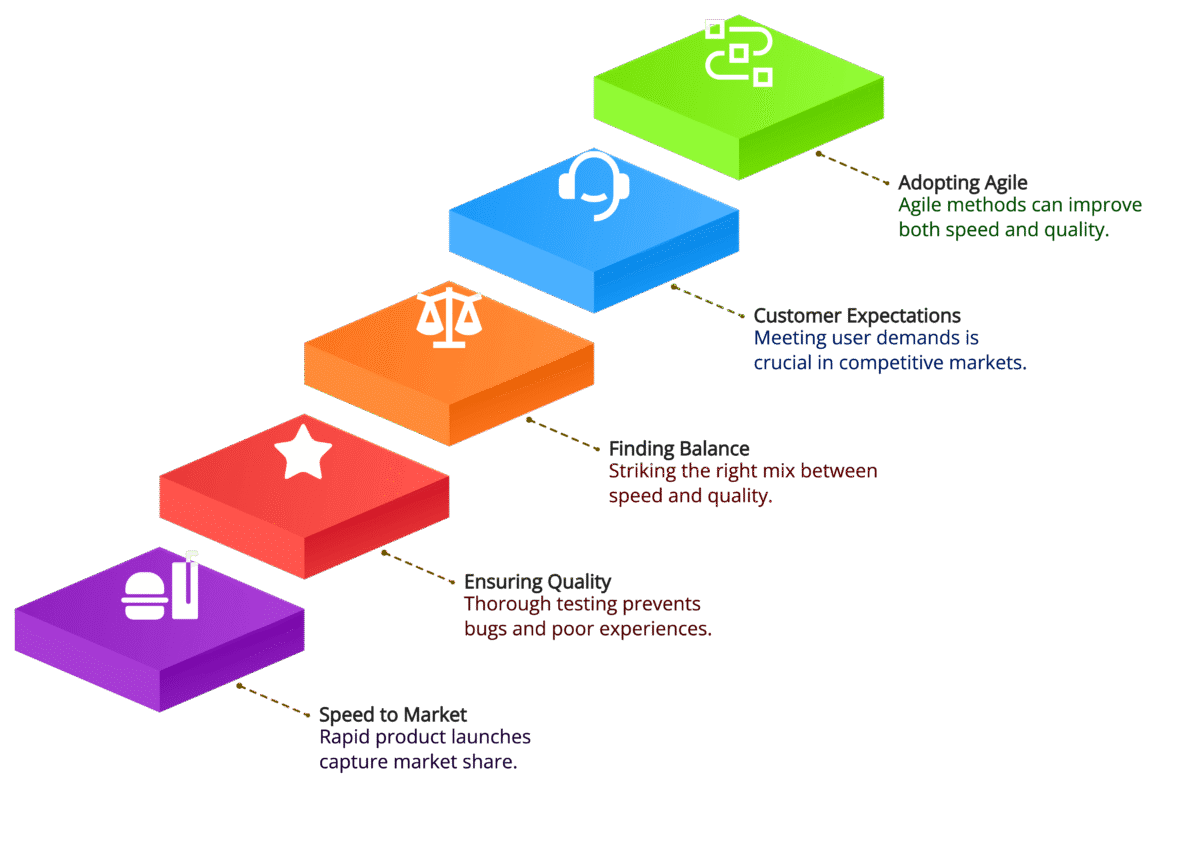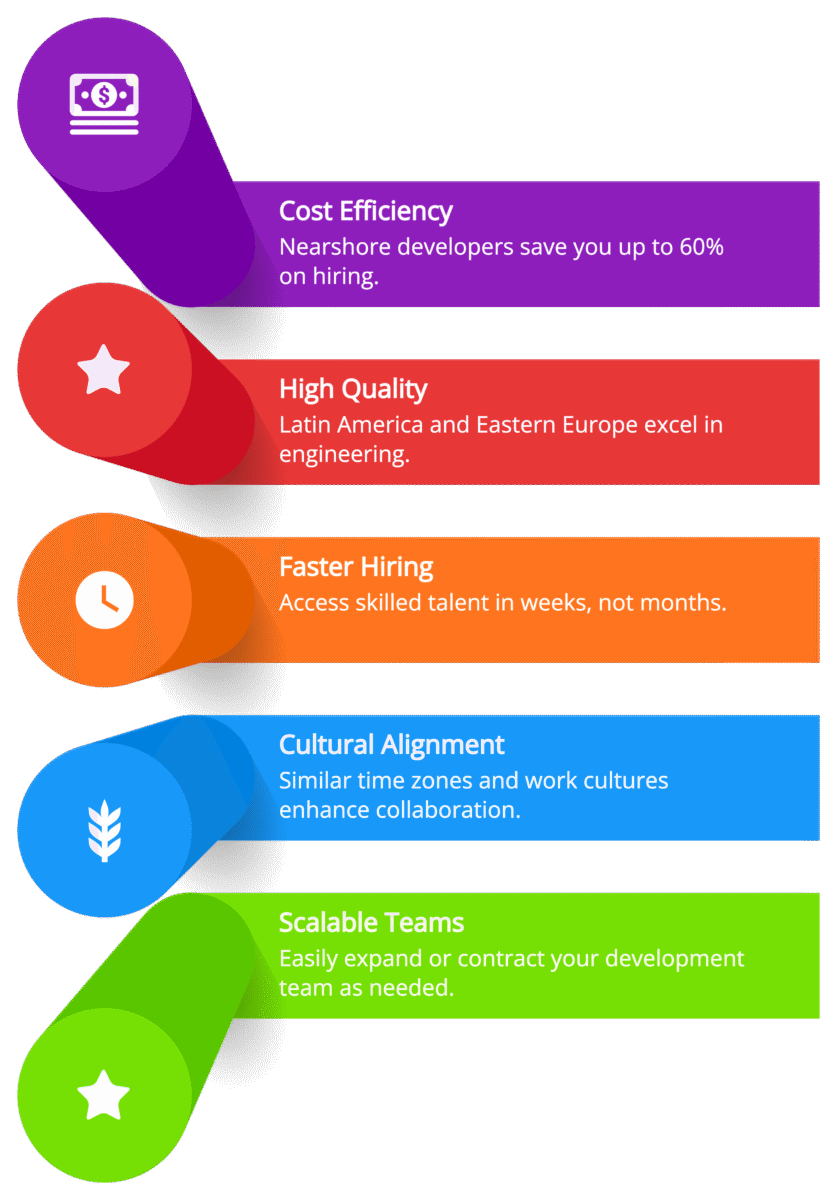
Improve time-to-market with nearshore software teams
“We can’t afford to miss another launch date,” Sarah, the CTO of a fast-growing e-commerce startup, told her team during a tense meeting. They had an ambitious product roadmap for the next year, but their in-house developers were stretched too thin. Deadlines kept slipping, and with each delay, the competition moved further ahead. Something had to change.
Thank you for reading this post, don't forget to subscribe!That’s when Sarah’s COO suggested exploring nearshore software development teams. Within six months, they were not only meeting their deadlines but actually delivering ahead of schedule. Here’s how partnering with a nearshore team improved their time-to-market and how it could do the same for your business.
The Challenge: Speed vs. Quality

Companies often grapple with a dilemma: how to balance speed and quality in software development. In the race to capture market share and keep up with shifting customer demands, businesses feel intense pressure to launch products quickly. However, the faster a product is pushed to market, the higher the risk of bugs, performance issues, and poor user experience. On the flip side, if too much time is spent perfecting every feature, the company risks missing critical market opportunities, allowing competitors to pull ahead.
For many organizations, including Sarah’s e-commerce startup, this tradeoff is particularly difficult to manage. Startups, by nature, operate under tight budgets and aggressive timelines, meaning there is little room for extended development cycles or delays. However, even larger enterprises aren’t immune to these challenges especially those in fast-moving industries such as fintech, media, and SaaS (software as a service).
Sarah’s team found themselves stuck at a crossroads. They had an ambitious product roadmap but lacked the resources to execute it on time. Hiring locally proved to be a significant hurdle. Skilled developers were in high demand, and recruiting the right candidates was both expensive and time-consuming. Each unfilled position created a bottleneck, stalling key initiatives and forcing the team to constantly reassess priorities.
Exploring offshore outsourcing seemed like a potential solution. Many companies have historically outsourced to countries like India or the Philippines, where labor costs are lower. However, Sarah’s team quickly discovered the downsides of this approach. Significant time zone differences meant that communication was often delayed by several hours. Urgent issues required overnight emails and waiting until the next business day for responses. Additionally, the asynchronous nature of the collaboration disrupted their agile workflow, making sprint reviews, stand-ups, and real-time problem-solving difficult to manage.
This is where nearshore development offered an ideal solution. Nearshore teams are based in geographically closer regions, often within the same or a neighboring time zone. For Sarah’s startup, partnering with a team in Brazil was a game-changer. Brazilian developers could attend daily stand-ups in real time, allowing for immediate feedback and rapid issue resolution. There was no need to adjust work schedules or rely on asynchronous communication. The shared time zone compatibility fostered stronger collaboration and reduced friction in agile cycles, such as sprint planning and retrospectives.
Moreover, nearshore teams offered a perfect blend of affordability and expertise. Developers in Latin America are often well-versed in modern technologies and software development practices, thanks to thriving tech ecosystems and partnerships with major global companies. Unlike distant offshore teams, nearshore developers are also more likely to have a cultural alignment with Western business norms, including familiarity with agile methodologies and fluent English communication skills.
With these advantages, Sarah’s company saw an immediate improvement in development pace. Features that had languished in the backlog for months were completed and delivered ahead of schedule. Instead of sacrificing quality for speed, they found that the nearshore partnership enabled them to achieve both accelerating time-to-market without compromising user experience. This balance between speed and quality is what makes nearshore development a strategic asset for companies navigating today’s high-stakes technology environment.
Ultimately, the challenge of balancing speed and quality is a universal one, but with the right approach such as nearshore development companies can gain a crucial edge in delivering innovative, high-quality products to market swiftly.
Accelerated Time-to-Market with Real-Time Collaboration
The key advantage of nearshore teams is real-time collaboration. Unlike traditional offshore teams, which may operate on entirely different schedules, nearshore developers are often only a few hours away in terms of time zones. This allows for:
- Smoother communication: Sarah’s developers could hold impromptu problem-solving sessions instead of waiting a full day for email responses.
- Faster feedback loops: Bugs and feature adjustments were addressed immediately, keeping projects on track.
- Agile development cycles: Daily stand-ups and sprint reviews ran efficiently, ensuring that goals were met with minimal delays.
In just three months, Sarah’s startup saw a 33% improvement in development speed. Features that had been stuck in backlog for months were finally launched.
Access to Top Talent Without Breaking the Bank

Recruiting top-tier developers can take months, especially in competitive tech hubs like Silicon Valley or New York. Nearshore regions, such as Latin America or Eastern Europe, have become talent hotspots due to their growing tech ecosystems and high-quality engineering education.
By tapping into this talent pool, companies like Sarah’s get access to highly skilled developers without the prohibitive costs of local hires. Nearshore developers typically offer:
- Competitive pricing: While more expensive than offshore teams in regions like Southeast Asia, nearshore developers still cost significantly less than local hires.
- Cultural alignment: Many nearshore developers are familiar with Western business practices and speak fluent English, reducing the risk of miscommunication.
Scaling Quickly to Meet Business Goals
Another benefit Sarah experienced was scalability. As her company’s needs evolved, the nearshore partner quickly added more developers to the project. This level of flexibility would have been nearly impossible to achieve with in-house hiring alone.
For startups and enterprises alike, this ability to rapidly scale is crucial. Market demands can shift overnight, and having a trusted nearshore team ready to ramp up can be the difference between capitalizing on an opportunity and missing it altogether.
Overcoming Common Misconceptions About Nearshore Teams
Some companies hesitate to explore nearshore development due to misconceptions about outsourcing. Sarah initially had concerns too, wondering if external developers would feel truly invested in her company’s success.
However, the reality was quite the opposite. The nearshore team became an extension of her in-house staff, fully integrated into their culture and workflows. By fostering a collaborative environment and treating the nearshore developers as equals, Sarah’s startup achieved remarkable alignment and productivity.
Is Nearshore Development Right for Your Company?
If your business is struggling with long development cycles or resource constraints, nearshore software teams could be the solution you’ve been looking for. Consider the following factors:
- Time zone compatibility: Will you benefit from real-time collaboration?
- Talent needs: Are you having trouble finding the right developers locally?
- Budget constraints: Can you achieve cost savings without sacrificing quality?
As Sarah’s story shows, nearshore development isn’t just a buzzword it’s a proven strategy for improving time-to-market. With the right partner, you can streamline your development process, outpace competitors, and bring innovative products to your customers faster than ever before.
So, what’s holding your team back? Have you explored how a nearshore partnership might accelerate your next big project?


